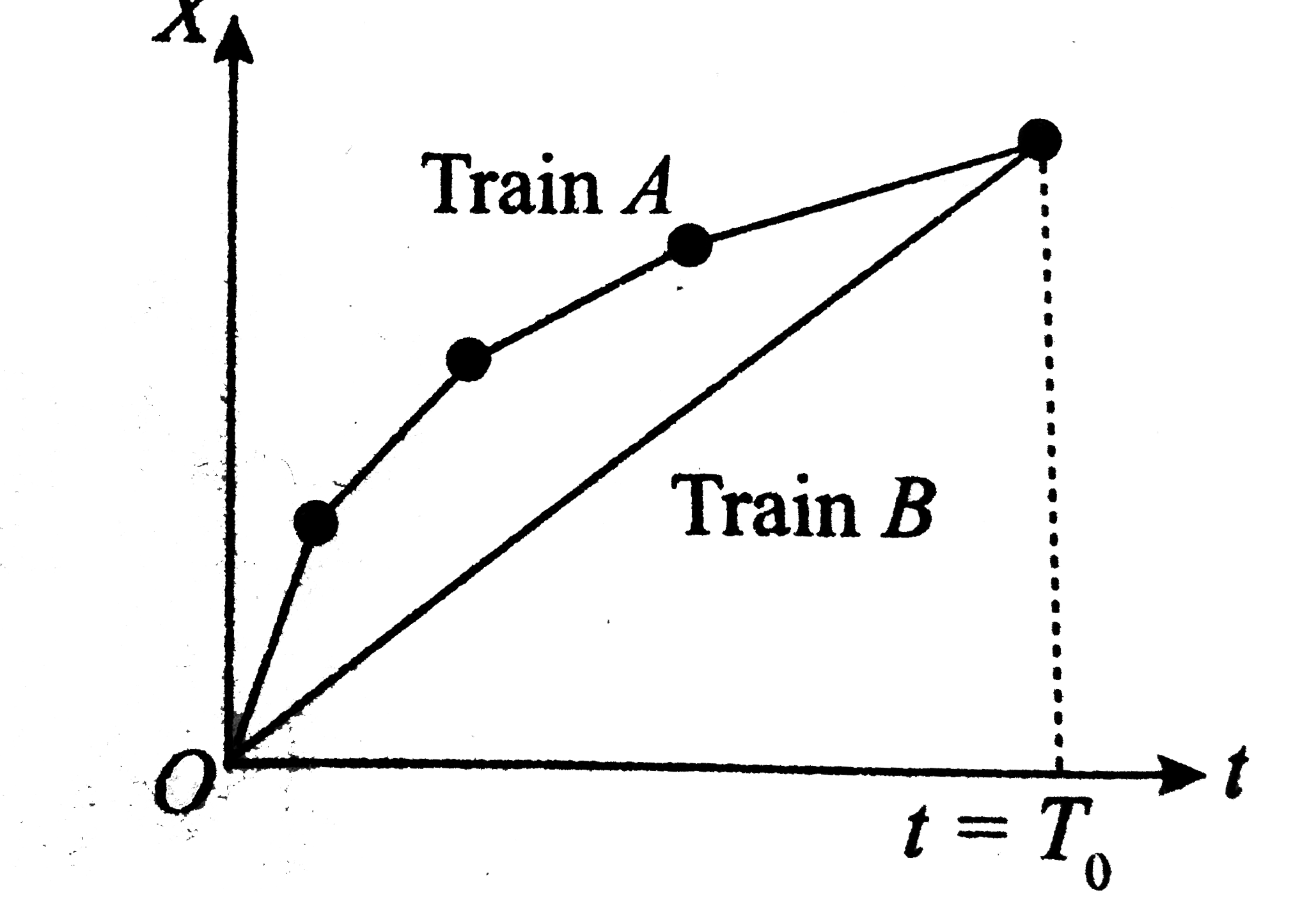The plot shows the position (x) as a function of time (t) for two trains that run on a parallel track. Train A is next to train B at t=0 and at t=T0.

At T0 both the trains have the same velocity.
Both the trains speed up all the times.
Both trains have the same velocity at some time before T0.
At T0 the trains have covered different distances
The correct Answer is:C
Initially slope of A is more than B and initially finally slope of A is less. So speed of A is initially more than finally less than B. So somewhere in between their speeds become the same.
Topper's Solved these Questions
- MISCELLANEOUS VOLUME 2BOOK - CENGAGE PHYSICS ENGLISHCHAPTER - MISCELLANEOUS VOLUME 2EXERCISE - MCQ_TYPE
20 Videos
- MISCELLANEOUS VOLUME 2BOOK - CENGAGE PHYSICS ENGLISHCHAPTER - MISCELLANEOUS VOLUME 2EXERCISE - LC_TYPE
34 Videos
- MISCELLANEOUS KINEMATICSBOOK - CENGAGE PHYSICS ENGLISHCHAPTER - MISCELLANEOUS KINEMATICSEXERCISE - Interger type
3 Videos
- NEWTON'S LAWS OF MOTION 1BOOK - CENGAGE PHYSICS ENGLISHCHAPTER - NEWTON'S LAWS OF MOTION 1EXERCISE - Integer
5 Videos
Similar Questions
The graph given show the position of two cars A and B as a function of time. The cars move along the x axis on parallel but separate tracks, so that they can pass each other's position without colliding.

At time t3 which car is moving faster?
View SolutionThe figure shows the velocity (v) of a particle plotted against time (t).

View SolutionThe figure shows the velocity (v) of a particle plotted against time (t).

View SolutionThe displacement s of an object is given as a function of time t
s=5t2+9t
Calculate the instantaneous velocity of object at t = 0.
View SolutionAn object is moving in the x-y plane with the position as a function of time given by →r=x(t)ˆi+y(t)ˆj. Point O is at x=0,y=0 . The object is definitely moving towards O when
View SolutionThe instantaneous velocity of a particle moving in a straight line is given as a function of time by: v=v0(1−(tt0)n) where t0 is a constant and n is a positive integer . The average velocity of the particle between t=0 and t=t0 is 3v04.Then , the value of n is
View Solution
A train A crosses a station with a speed of 40 m/s and whitles a short pulse of natural frequency n0=596Hz another train B is approaching towards the same station with the same speed along a parallel track, Two track are d=99m apart. When train A whistles. train B is 152 m away from the station as shown in Fig. If velocity of sound in air is v=300ms. calculate frequency of the pulse heard by driver of train B.
View Solution
A train A crosses a station with a speed of 40 m/s and whitles a short pulse of natural frequency n0=596Hz another train B is approaching towards the same station with the same speed along a parallel track, Two track are d=99m apart. When train A whistles. train B is 152 m away from the station as shown in Fig. If velocity of sound in air is v=300ms. calculate frequency of the pulse heard by driver of train B.
View Solution
A train A crosses a station with a speed of 40 m/s and whitles a short pulse of natural frequency n0=596Hz another train B is approaching towards the same station with the same speed along a parallel track, Two track are d=99m apart. When train A whistles. train B is 152 m away from the station as shown in Fig. If velocity of sound in air is v=300ms. calculate frequency of the pulse heard by driver of train B.
View Solution
A train A crosses a station with a speed of 40 m/s and whitles a short pulse of natural frequency n0=596Hz another train B is approaching towards the same station with the same speed along a parallel track, Two track are d=99m apart. When train A whistles. train B is 152 m away from the station as shown in Fig. If velocity of sound in air is v=300ms. calculate frequency of the pulse heard by driver of train B.
View Solution
